About 15 years ago, observers diagnosed banks with two different, but serious, ailments. First, the banking industry overall was seemingly in the last stages of the plague. Roughly 1,200 banks (about 10 percent of the total population) had died in the 1986–92 period.1 Second, and perhaps even more foreboding, the banking industry had chronic wasting disease. Bank competitors, such as finance companies and securities firms, had picked up significant market share. These competitors provided the same services as banks but perhaps more proficiently. Even if banks recovered from the short-term pandemic, some experts warned, they might succumb to the longer-term threat.
 While bankers, bank employees and bank supervisors naturally worried about the alleged demise of their industry, why would anyone else care?
After all, firms come and go in the United States; entire industries facing product innovation or new competitors go extinct with little outcry from the public at large. Economists typically view such dynamism favorably, as it helps promote economic growth.
While bankers, bank employees and bank supervisors naturally worried about the alleged demise of their industry, why would anyone else care?
After all, firms come and go in the United States; entire industries facing product innovation or new competitors go extinct with little outcry from the public at large. Economists typically view such dynamism favorably, as it helps promote economic growth.
But economists have also traditionally viewed banks as offering unique and beneficial services that other firms might not easily replace.
Historically, banks have played a key role in providing credit to firms. In addition, banks offer an exceptional investment option: deposits that households and firms can redeem for their full value on demand. Because policymakers considered banks special, an elaborate system of government support was created to ensure continued provision of banking services even when banks faced failure. An equally elaborate system of government regulation was created to ensure that banks operate according to practices considered safe and sound.
The potential demise of banking therefore raised questions the broader public should care about. What if banks’ declining market share reflected the ability of other firms to offer bank-like products? In that case, society should consider rolling back government support for banks. Alternatively, banks’ declining market share might reflect excessive regulation that competitors did not face. Policymakers might consider relaxing rules and oversight in that case.
For these reasons, getting the market share calculation right in the first place mattered and justified a second opinion. In 1994, John Boyd and Mark Gertler (BG) questioned whether the death of banks had been “greatly exaggerated” because of a mistaken calculation of their market share.2 After adjustments to reflect banks’ new “off-balance-sheet” activities or technology, BG concluded that banks’ market share had held firm.3 Moreover, banks’ contribution to economic output had not fallen. BG’s analysis and other research that came to the same conclusion, along with very strong bank performance, seemingly put these issues to rest.4
But in recent years, the same concerns have recurred. Many observers argue that banks now face daunting new competitors, such as sophisticated and well-funded pools of private equity, which make effective use of off-balance-sheet technology. Have these threats diminished the importance of banks?
We give a first-cut answer to this question by replicating BG’s widely cited approach. We find results similar to BG’s. That is, after adjustments are made, banks’ market share and economic contribution continue to hold steady.
But then we examine the BG approach more critically. After all, times have changed, and an approach suitable 15 years ago may face limitations today, particularly since BG noted several weaknesses in their original analysis. We find, in fact, that recent financial market developments make these original limitations more serious. The absence of comprehensive data on bank competitors makes it virtually impossible to draw rigorous conclusions about relative market shares. We conclude by asking whether or not these limitations justify additional investment in data collection.
Before we examine the new threat to banking, we note again that BG’s work was more than an accounting exercise. The uniqueness of banks motivated their market share analysis. But BG also took on banks’ special qualities directly. BG concluded that despite the new technology of banking, the core functions that defined and differentiated a bank from other financial institutions still held. They argued that “in many cases, further, the growth of off–balance sheet activities reflects only superficial rather than substantive changes in the nature of banking. …Thus we strongly caution against interpreting movement to off–balance sheet activities as indicating that banks are moving into completely new lines of business and abandoning old ones.”5 In a forthcoming Region article, we will analyze whether that conclusion still holds.
Why update Boyd and Gertler?
Data and anecdotes discussed below suggest that nonbank financial intermediaries have banks in their cross hairs. We first cite examples where banks face challenges in consumer and commercial lending. We then review how these examples manifest themselves in the most comprehensive data on financial intermediation (that is, roughly speaking, the process by which firms convert savings into financial assets).
Consumer lending. Banks now hold 30 percent of consumer loans (not secured by real estate) on their books. In 1990, they held nearly 50 percent.6 Over the same period, banks have seen slight gains in their share of the mortgage market. Yet, during subsets of that time period, including some very recent years, the growth in the home mortgage market share of government-sponsored enterprises (GSEs) has vastly eclipsed that of banks.7
Commercial lending. The largest corporate loans get “syndicated”; a lender or a group of lenders issues the loan and distributes it to a variety of holders. Nonbanks have assumed a larger role in this market, although banks still dominate. Nonbanks now hold about 14 percent of the syndicated loans reviewed annually by bank supervisors, up from 8 percent in 2001.8
Nonbanks have made more substantial gains in syndicated lending to firms in weak conditions. Some observers point to these gains to “illustrat[e] how banks continue to be disintermediated by nonbank investors.”9 Data on other subsets of syndicated loans support that conclusion. Nonbanks made about two-thirds of syndicated term loans (worth about $230 billion) in 2006 in what had historically been a bank-dominated market.10
Some cite the rise of “new” intermediaries as underlying these trends: “As commercial banks back away from making corporate loans, a new breed of lender is stepping in: hedge funds.”11 Other intermediaries also pose new competition. A survey of the “fastest growing” firms in the United States reports that “the abundance of venture capital and private equity available to the fast-growth companies is leading borrowers and non-borrowers alike to explore non-traditional financing methods to obtain the capital they need to grow.”12
Borrowers also appear to have greater access to investors through capital markets, such as that provided by lower-credit-quality bonds (so-called junk bonds). The percentage of bonds that fall into the junk category has risen from 30 percent in 1980 to about 70 percent. This trend has supposedly freed firms from exclusive reliance on bank funding.13 And firms that many think of as holding only stocks or bonds now willingly take on exposure that had been the domain of banks; “bank loan” describes the focus of roughly 100 mutual funds.14
One might dismiss these trends as applying only to the largest corporate customers of banks. And it remains true that commercial banks provide the overriding share of financial services to small firms. Yet the material change in the percentage of small firms using a nondepository but primarily financial provider of financial services from 1987 to 2003 (from 27 percent to 40 percent) cannot make bankers sleep easy.15
More comprehensive intermediation data. Figure 1—which relies on the Federal Reserve’s flow of funds data—brings all of these factors together. The figure displays the market share of all financial intermediation for four major classes of institutions: banks, thrifts, insurance companies and other. “Other” firms range from finance companies to the entities that issue asset-backed securities (ABS).16 Typically, a bank, security firm, investment group or other firm creates a stand-alone legal entity to issue ABS. Payment to ABS investors comes from a larger group of “securitized” financial assets (for example, student loans, credit card loans) underpinning it.
The figure presents what seems like a fairly straightforward story, both for the period that motivated BG’s analysis and for the current one. Banks’ share of financial intermediation fell about 10 percentage points from a peak in the mid-1970s to when BG published their analysis in the early 1990s. Since then it has fallen another couple of percentage points before flattening out over the past few years.
In contrast, the “other” category of firms gained about 20 percentage points during the same 1970s-to-early-1990s period. Since BG’s analysis, these firms have gained another 15 percentage points. The most recent period has seen an acceleration of that trend.
What underlies these changing market shares? We have mentioned many examples, but in general, the new technology of producing financial services seems key to understanding the trend. BG focused on this change in technology. In particular, they argued that the standard measurements employed in Figure 1 fail to measure banks’ activity accurately. We now turn to the BG approach and replicate it for the current period.
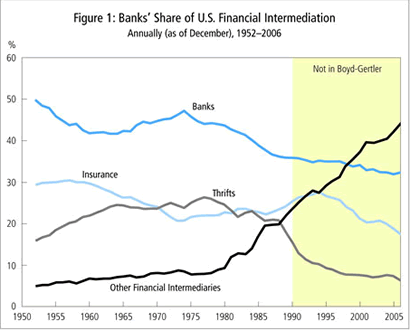
Source: Federal Reserve Board of Governors
Extending Boyd and Gertler
BG identified several failings with the unadjusted data used to measure banks’ importance. We discuss these failings first. We then extend their analysis to the current period.
The need to correct the data. BG raised two key concerns with the data in Figure 1 and, implicitly, with the other data and anecdotes that support the claim that banks faced a serious threat to their livelihood.
First, these data are limited to on-balance-sheet assets, that is, assets that banks own outright. This focus reflects one aspect of bank intermediation but misses other increasingly important aspects of bank operations. For example, we mentioned the process of securitization in the context of competitive threats to banks. Securitization also provides enormous benefits to banks, however, and they make extensive use of it. At of the end of 2006, the hundred largest banks had securitized loans with outstanding balances of at least $1.3 trillion.17
In a number of cases, banks create the vehicles that issue ABS and earn revenue from the securitized pool of loans (after the payments from the loans satisfy the claims of ABS investors). But statistics count the ABS and bank credit extensions separately. Banks’ decline in consumer finance mentioned earlier occurred when the share of that market held by pools of securitized loans increased from about 5 percent to about 30 percent.18 Even if banks do not securitize the loans, they often generate the assets that others pool and earn fees in the process.
Banks earn fees from other types of off-balance-sheet intermediations as well. Banks issue lines of credit against which borrowers can draw in the future, and they earn fees whether or not borrowers use the lines. Even on the deposit side of activities, bank fees can embody intermediation. Consider charges to deposit accounts for a “bounce protection” service that allows customers to overdraw their accounts (that is, get a short-term bank loan) for a specified charge.
BG also argued, in their second major concern, that standard intermediation data may provide an incomplete picture of bank activity. The gross domestic product of the United States measures the size of the country’s economy and its overall well-being. This suggests we look to banks’ contribution to GDP over time to figure out if banks have become more or less important.
To determine banks’ share—a crucial fact in assisting policymakers in evaluating the unique policies that apply to “special” banks—BG proposed three adjustments to banks’ assets:
To address the first concern, BG collected data on the off-balance-sheet exposures of banks and added them back into the balance sheet. In another approach, BG used data on the fee income of banks (technically called the noninterest income because this revenue does not come from the interest paid on loans or other bank assets) to measure activity not captured on the balance sheet. Effectively, they took the flow of fee income that banks receive over a year and converted it to the equivalent of an on-balance-sheet asset.
To address the second concern, BG attempted to isolate banks’ contribution to GDP from that of other firms.
Correcting the intermediation data. To implement their first correction, BG had to find measures of banks’ off-balance-sheet activity that facilitated conversion into on-balance-sheet equivalents. Such a transformation would allow an apples-to-apples combination of the two activities. BG used “credit equivalents” created by bank supervisors to capture exposures that do not show up on the banks’ balance sheets (called Basel credit equivalents after the Basel capital accord that many countries agreed to follow). Supervisors want banks to hold capital against these potential exposures and thus need a measure of their value.19
Figure 2 adjusts the share of financial intermediary assets already reported in Figure 1 to add in credit equivalents. This has the effect of increasing banks’ share at every point in time. In particular, after a period of decline, banks’ adjusted share has returned nearly to the peak level of the late 1970s. (We will return to the fact that only the bank share of the market benefits from this adjustment.)
Because it focused on converting fee income into a balance-sheet asset, implementing the second correction required a different set of data and a different framework. The data for this correction come from bank regulatory reports that document the amount of (1) income banks earn from the interest they charge on loans, (2) the expenses of generating interest income (for example, expected losses on loans) and (3) the income banks earn from noninterest sources.20 BG focused on the relationship between the net interest income banks earn [the difference between items (1) and (2), which reflects their on-balance-sheet activities and their noninterest income, item (3)].21
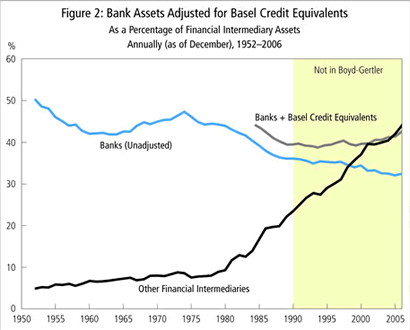
Sources: FDIC, Federal Reserve Board of Governors
In this framework, the more noninterest income a bank generates relative to interest income, the more off-balance-sheet activity it has relative to on-balance-sheet activity. To transfer this ratio of noninterest income to interest income into a credit equivalent, BG simply multiplied it by the bank’s on-balance-sheet assets. For example, a bank with on-balance-sheet assets of $10 billion whose noninterest income equals 50 percent of its interest income would have a credit equivalent of $5 billion for its off-balance-sheet activity. BG then added this credit equivalent to the on-balance-sheet measure for banks.
Figure 3 shows banks’ market share adjusted by this noninterest income equivalent (along with the other data included in Figures 1 and 2). The adjustment shows banks’ share holding roughly steady over the past 30 years.22
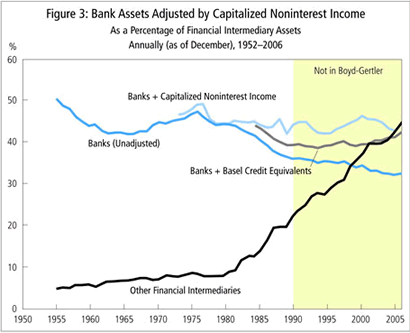
Sources: FDIC, Federal Reserve Board of Governors
In sum, the original BG conclusion still holds. Even with these adjustments, however, the position of banks relative to other financial intermediaries has changed. Thirty years ago, banks’ market share exceeded all other firms’ by at least 20 percentage points. Now banks find themselves in a dead heat with other firms, after accounting for off-balance-sheet efforts. (In addition to examining off-balance-sheet activities, BG also found that the treatment of certain U.S. activities of foreign banks can materially change banks’ market share. We discuss and replicate this distinct analysis in "Adjusting for offshore loans.")
Using GDP data. Banks are part of the financial services sector, and saying that they have become less important implies that their slice of that sector has shrunk relative to that of other financial service providers or to GDP. To check this assertion requires that analysts go outside direct measures of banking assets (on- or off-balance-sheet) and instead look to overall measures of output.
The U.S. Department of Commerce calculates such output figures for the credit sector. Ideally, we would use data specific to the output of banks and banks alone. Unfortunately, Commerce lumps bank data with output data for other financial firms.
The firms with which Commerce groups banks has changed over time. For some of the time period examined by BG, Commerce grouped commercial banks with mutual savings banks. Over the last years examined by BG, Commerce grouped banks with an even broader range of institutions, including GSEs (private firms that benefit from implied government support to direct credit to certain borrowers).23
We must rely on that latter, broader series when examining bank contributions to GDP. Like BG, we call this broader series banks + credit to highlight its coverage. We will discuss the limitation of using this series approach in the next section.
As seen in Figure 4, banks’ share of output generated by financial intermediaries fluctuates. In the period BG examined, the share moves around a flat trend line. In the subsequent period, the share falls a bit during the first two-thirds of the time period only to return to close to the original level.24 Figure 4 also shows the increase in output from other financial intermediaries.
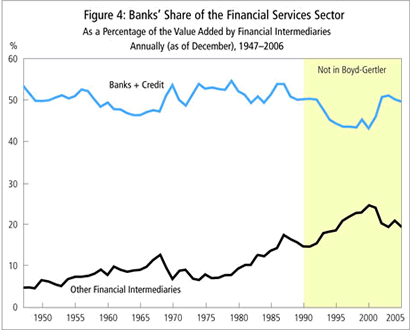
Source: U.S. Department of Commerce
How appropriate is the Boyd and Gertler approach for today’s market?
Policymakers have historically treated banks as if they were special. A declining market share for banks might suggest that they had become more ordinary or were facing excessive and deleterious government attention. Policymakers therefore need accurate measures of banks’ market share.
BG offered a widely cited approach to determining the relative importance of banks to the business of intermediation. In the hope that it would better inform policymakers—or at least support the principle of “first, do no harm”—a senior Federal Reserve official recommended at that time that central banks regularly update the BG approach.25 But BG recognized at least three imperfections in their approach, all generally related to the availability of data. Given the transition to the “information economy” and the vast expansion in financial databases since BG’s publication, we might expect a diminution of these concerns. We find the opposite.
First, GDP data do not isolate the contribution of banks. This problem poses a greater challenge to us because the data we use obscure banks’ role to a greater extent than did BG’s data. But alternative measures we use suggest that BG’s GDP finding still holds today.
Second, we cannot make the off-balance-sheet data adjustment to nonbank institutions. Thus the BG approach biases results to find increased bank market share. Again, this problem is worse for us than for BG. As our data analysis has shown, other financial institutions now play a larger intermediary role.
Finally, BG’s approach requires an assumption that banks generate equal levels of profitability in their traditional and nontraditional activities. We cannot easily verify this assumption. That said, it seems plausible.
Limitations. Our GDP data for banks include information on mortgage bankers and brokers, credit unions, pawnshops and GSEs, among other
nonbanks. This makes it difficult to pin down the degree to which bank activity drives the data. For example, the two housing GSEs (Fannie Mae and Freddie Mac) had tremendous growth from 1987 into the early 2000s: The on-balance-sheet assets and the securities they guaranteed rose nearly ninefold from 1987 to 2002 (from $477 billion to $4.1 trillion).26
This presents a real, but not insurmountable, problem because we have related data that break out the share of banks from that of other institutions. The government uses a measure roughly akin to profits before taxes to determine the contribution of financial firms to GDP. We gather data on profits before taxes for publicly traded financial firms, including Fannie and Freddie, thrifts, securities firms, insurance firms and the like. We examine the annual data since 1990; the number of firms in our sample ranges from about 200 in 1990 to about 900 in 2006.27
Based on that sample, we calculate banks’ share of the financial services sector’s total profits before taxes. We find that banks tended to hold about a third of the market share in the first several years of the sample. This share shifts to about half of the market share in the later periods when we have a large sample of firms (see Figure 5). These results generally confirm results from the broader GDP data we use to replicate BG.28
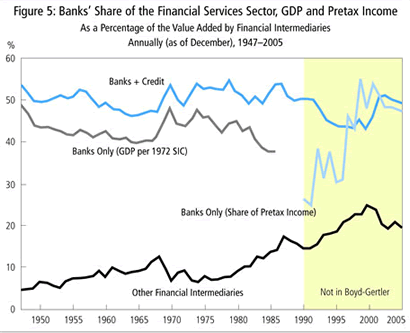
Sources: U.S. Department of Commerce, Bloomberg
While BG did not examine it, the level of firm entry into the banking market provides a reality check on claims about overall banking health. We would not expect much entry if banking were on its last legs. From 1995 to 2005, the Federal Deposit Insurance Corp. reports a fall of about 2,500 bank charters (or roughly 25 percent of the 1995 total, the year after BG ’s analysis came out). The decline reflects ongoing consolidation in the banking industry (as opposed to the mass failures of earlier periods). Despite the high level of merger activity, roughly 1,700 new banking charters were created during the same period.29 This proxy for the level of new firm entry suggests providers of capital do not see the industry as dying.
Lack of adjustments for off-balance-sheet activity of nonbanks. BG adjusted banks’ data for off-balance-sheet activity and then recalculated market shares. However, other financial firms make extensive use of off-balance-sheet activity. Consider this description of the evolving role of the largest securities firms from a Securities and Exchange Commission commissioner.
Behind the numbers is an expansion into new and increasingly complex businesses that reflect, in part, market demand for an ever expanding array of financial services and products. Derivatives provide the most obvious example. Securitization structures, which finance assets, from mortgages to credit card receivables, also have become a substantial business for brokers. Over the years, broker-dealers have led the way in devising financial products and providing all the transactional pieces necessary to build complex financing packages, including underwriting of securities, derivatives, and hedging, origination of lending commitments, and advice.30
These sentiments apply, perhaps even more aptly, to pools of private equity taking on credit risk. Yet, these nonbanks receive no “credit” for this intermediation in the BG accounting. As BG recognized, “Our numbers may be biased, however, in that we have not been able to take account of off–balance sheet activities of other financial intermediaries due to a lack of data availability. … Our adjusted numbers may overstate banks’ share of intermediated asset holdings.”31
We have no way around this limitation. The data needed to make such adjustments generally do not exist. When data exist, they come in such an incomplete or disaggregated form that we cannot reasonably make the adjustments. We cannot fix the problem by making targeted adjustments to banks’ balance sheets in place of BG’s systematic approach, as some have suggested. To avoid biasing the results, we would need to make targeted changes to other firms’ balance sheets, and we cannot.32
To understand the general problem, consider the case of hedge funds. Federal Reserve testimony on these nonbanks cites reports that they play an important role in funding and bearing credit risk through the purchase of securitized assets (for example, ABS and collateralized debt and loan obligations). Fed officials had to rely on third-party reports as a primary source, however, because “the role that hedge funds are playing in capital markets cannot be quantified with any precision.”33 In fact, hedge fund activities do not show up in the “other” category of financial institutions in the flow of funds data. Their activity falls into the “household” sector, which holds all the intermediation that, due to a lack of data, analysts cannot attribute to specific institutions.
This problem did not undercut BG’s analysis as much as it does ours. Judging by the unadjusted data and their use of off-balance-sheet activity, nonbanks likely play a much larger role today than they played in the past. BG also found solace in their analysis of GDP data. That analysis confirmed the finding from the balance-sheet adjustment, even if flawed, and relied on a completely different data set and methodology. We take comfort from that result, but do not want to overstate its importance. For example, the GDP analysis relies on a pretax-profits measure that may not be a good proxy for intermediation activity.
Profitability assumption. To create on-balance-sheet equivalents for banks’ off-balance-sheet activities, BG assumed that all bank assets have the same profitability. Other analysts have tried to avoid the assumption, seemingly because of difficulty confirming it.34 We find the assumption plausible, however. Banks face expectations from shareholders that they maximize returns. They also have significant freedom to change the composition of their assets or activities, acquiring some in one time period or geography and dropping them in others. Through such shifting, we would expect returns on banks’ new activities and assets to roughly match the return on existing assets.
Conclusion and policy question
A number of observers suggest that banks currently face intense competition. Similar observations made years ago led some to suggest that banks were dying. After accounting for the changing way banks carried out their business, Boyd and Gertler concluded in 1994 that banks retained significant intermediation market share and continued to provide relatively unique services.
The new technology of banking continues to transform how banks operate. It also makes it possible for competitors, both new and old, to take on banks. And, ironically, this new technology makes it very difficult to implement the BG approach in the current period. We simply do not have the data needed to adjust the balance sheets of all financial firms to properly determine their relative market share.
Should the Fed or another agency collect or purchase data in order to more completely implement the BG approach? Would the cost of acquiring additional data exceed the benefits that might result?35 We do not know how many resources this data collection would consume or whether meaningful data are even available. But the benefits are material: The motivation that prompted BG’s analysis in the first place—that good policy on banking requires a solid sense of banks’ market share—seems just as strong today as it did in the 1990s.
Endnotes
1 The term “banks” refers to commercial banks unless otherwise noted. Authors’ calculations are based on the Federal Deposit Insurance Corp.’s “Bank and Thrift Failure Report.”
2 John H. Boyd and Mark Gertler. 1994. “Are Banks Dead? Or Are the
Reports Greatly Exaggerated?” Federal Reserve Bank of Minneapolis
Quarterly Review 18 (Summer): 2–24.
3 Narrowly speaking, analysts define off-balance-sheet items by their contingent nature; an on-balance-sheet loan reflects cash outflows a bank has made, whereas an off- balance-sheet letter of credit may require a payment in the future. Broadly speaking, BG focused on bank income that does not derive from its on-balance-sheet loans.
4 For analyses that came to conclusions similar to those of BG, as well as others that did not, see The Declining Role of Banking: Proceedings of the 30th Annual Conference on Bank Structure and Competition, Federal Reserve Bank of Chicago, 1994. For a review of the literature from the early 1990s and an analysis of banks’ importance in credit markets in the current period, see Katherine Samolyk, 2004, “The Evolving Role of Commercial Banks in U.S. Credit Markets,” FDIC Banking Review 16 (1-2): 29–65.
5 See Boyd and Gertler, p. 8.
6 Authors’ calculations are based on data from the Federal Reserve Statistical Release G.19., Consumer Credit.
7 Authors’ calculations are based on Federal Reserve Statistical Release Z.1., Flow of Funds, L.218.
8 Board of Governors of the Federal Reserve System, Federal Deposit
Insurance Corp., Office of the Comptroller of the Currency, Office of
Thrift Supervision. 2006. “Shared National Credit Data Reflect Good
Credit Quality Performance, Large Increase in Credit Commitment Volume,
and Small Rise in Riskier Deals.” Joint Press Release. Sept. 25.
9 Reuters Loan Pricing Company. 2006. “1Q06 U.S. Syndicated Lending: The Borrower’s Market Continues.” Press Release. March 31.
10 Randall S. Kroszner. 2007. Recent Innovations in Credit Markets.
Speech to the 2007 Credit Markets Symposium. March 22.
11 Mara Der Hovanesian. 2005. “Hedges: The New Corporate ATMs.”
BusinessWeek. Oct. 31.
12 PricewaterhouseCoopers. 2006. “New Bank Loans Remain Low Among Fast Growth Companies as Interest Rates Level Off.” News Release. December 26. In a May 30, 2006, press release, PricewaterhouseCoopers highlights data suggesting that “Few Fast-Growth Companies Involved in Bank Financing.”
13 Serena Ng. 2007. “Junk Turns Golden, But May Be Laced With Tinsel.” Wall Street Journal. Jan. 4, C1.
14 Morningstar listed 103 mutual funds under the category of “bank loan” on June 28, 2007.
15 For 2003 data on small business use of nonbank financial service
providers, see Traci L. Mach and John D. Wolken’s “Financial Services
Used by Small Businesses: Evidence from the 2003 Survey of Small
Business Finances,” Federal Reserve Bulletin, October 2006, A182. For
1987 data on small business use of nonbank financial service providers,
see Gregory E. Elliehausen and John D. Wolken’s “Banking Markets and the
Use of Financial Services by Small and Medium-Sized Businesses,” Federal
Reserve Bulletin, October 1990, 806.
16 Specifically, “other” includes mutual funds, finance companies, securities brokers and dealers, ABS issuers, real estate investment trusts and funding corporations. To be consistent with how BG appear to have carried out their analysis, we include private pensions with “insurance,” but do not include local, state and federal pensions, GSEs (for example, Fannie Mae) and the federally sponsored mortgage pools they establish as part of the financial intermediation universe.
17 This figure—our calculation based on the Federal Financial Institutions Examination Council Call Report’s RC-S section—understates bank activity because it reflects only securitizations where the reporting bank continues to service the loans or retains credit exposure to them.
18 Authors’ calculations are based on data from the Federal Reserve Statistical Release G.19., Consumer Credit.
19 The financial reporting required of banks for these exposures includes the following types of off-balance-sheet activities: standby letters of credit, participations in bankers’ acceptances, retained recourse on assets sold, securities lent, derivatives and unused loan commitments. For calculating regulatory capital requirements, the volume of these activities is weighted by a conversion factor to obtain their credit equivalent. Because of modifications to these reports, the off-balance-sheet activities with available credit equivalents have changed over time.
20 Sources of noninterest income include, for example, charges on deposits, income from trading financial assets, income from securitization and the outright sale of loans, and the fees earned from a number of activities typically not considered traditional banking, such as investment banking, venture capital and insurance underwriting/brokering.
21 In fact, BG created two measures of capitalized noninterest income. They calculated one as described in the text. To create the other, they subtracted an estimate of noninterest income earned from low-risk activities from total noninterest income. They argued that this subtraction creates an adjusted capitalized measure they could more easily compare to the Basel credit equivalent measure. We use this latter measure because BG emphasized it in their presentation. That said, we find the former, nonadjusted measure superior because it does not require assumptions used to generate the adjusted measure. For example, in calculating the adjusted risk measure, BG assumed that banks generate all noninterest income from “primarily safe, plain-vanilla services” during the 1961–70 period. In any case, our results do not change materially when we use the unadjusted capitalized measure.
22 BG reported similar results using percentage of GDP to normalize the findings. We replicate those findings as well and find similar results.
23 In addition to changing the composition industry groupings over time, the U.S. Department of Commerce’s Bureau of Economic Analysis has changed the manner in which it calculates the value added of banks. In particular, the BEA revised its accounting of income from services for which banks do not explicitly levy a charge, for example, interest income. For a discussion of this change, see “Measuring the Services of Commercial Banks in the NIPAs,” Survey of Current Business, September 2003.
24 BG reported similar results using percentage of GDP to normalize the findings. Here the results differ, as both banks and other financial intermediaries show a fairly constant gain over the period.
25 Edward Ettin. 1994. “The Evolution of the North American Banking System.” Paper prepared for the Experts’ Meeting on Structural Changes in Financial Markets: Trends and Practices. Organization for Economic Cooperation and Development, Paris, July 11–12.
26 Office of Federal Housing Enterprise Oversight. 2007. Report to Congress, 102. Indeed, this growth and concomitant concerns about risk taking have become central to current financial institution policy debates. For a discussion, see Federal Reserve Bank of St. Louis President William Poole’s 2007 speech to the Chartered Financial Analysts of St. Louis, “The GSEs: Where Do We Stand?”
27 Authors’ calculations are based on pretax-profits data gathered from Bloomberg. The Federal Deposit Insurance Corp. published a similar analysis and found similar results, but focused on net income. See Samolyk (2004).
28 We characterize the pretax data as confirmatory rather than as a precise measure of market share for two reasons. First, the data reflect the income of publicly traded firms only, although such firms likely hold the lion’s share of profits before taxes. Second, we rely on standard industrial classifications to determine the categorization of a firm as a bank, security firm and so on. Many large financial firms carry out an array of activities, so classifying them as a single type of firm may not properly segment their activities. This same problem occurs outside the financial sector because some industrial firms not included in our sample also have large credit granting operations (for example, General Electric). But neither of these issues would bias our results in favor of banks. (For example, some securities activities occur in banks, but some securities firms own banks.)
29 Authors’ calculations are based on data from the Federal Deposit Insurance Corporation, Historical Statistics on Banking, accessed
June 13, 2007.
30 See SEC Commissioner Annette L. Nazareth’s “Remarks Before the SIFMA Compliance and Legal Conference,” 2007.
31 See Boyd and Gertler, p. 5.
32 For example, some banking organizations own both banks and nonbanks. The nonbank lending gets reported in the “other” category. In the spirit of BG, Ettin (1994) adjusts the flow of funds data to credit such loans to banks. But some large securities firms own the banks or bank-like equivalents (for example, industrial loan companies, or ILCs), and this methodology makes no adjustment for them. Because ILCs have grown much larger over the past 10 years, it becomes more problematic to not give the owners credit for their activity. See 2007 testimony (“Industrial Loan Companies”) of Governor Donald L. Kohn before the Committee on Financial Services, U.S. House of Representatives, for a discussion of ILC growth.
33 See 2006 testimony (“The Role of Hedge Funds in the Capital Markets”) of Patrick M. Parkinson before the Committee on Banking, Housing, and Urban Affairs, U.S. Senate.
34 Kevin J. Stiroh. 2006. “A Portfolio View of Banking with Interest and Noninterest Assets.” Journal of Money, Credit, and Banking 38 (5): 1351–61.
35 Federal Reserve Chairman Ben S. Bernanke and others have raised concern that some new data collection proposals regarding hedge funds would add little insight and raise moral hazard concerns. See 2006 remarks (“Hedge Funds and Systemic Risk”) by Bernanke. Data to implement the BG approach, however, would not seem to raise these concerns, as they could have a low-frequency and highly aggregated nature. Use of the data for research rather than supervisory purposes might also alleviate moral hazard concerns.






